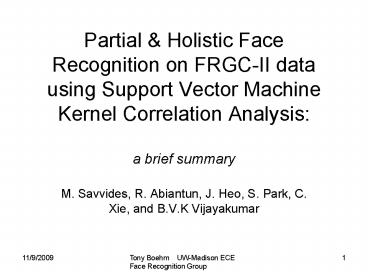Partial - PowerPoint PPT Presentation
1 / 23
Title: Partial
1
Partial Holistic Face Recognition on FRGC-II
data using Support Vector Machine Kernel
Correlation Analysis a brief summary
- M. Savvides, R. Abiantun, J. Heo, S. Park, C.
Xie, and B.V.K Vijayakumar
2
Presentation Outline
- Background Material
- Correlation Filters ? MACE ? Kernel Correlation
Filters - Support Vector Machines
- Partial vs. Holistic Face Recognition
- Results
3
Correlation Pattern Recognition
- Matched Spatial Filter (MSF)
- Uses frequency domain
- Optimal in noise
- Spatial freq. domain proven in (ATR)
- No need for image segmentation
- Closed form expression
- - Need new classifiers for multiple orientations
4
Synthetic Discriminant FunctionHester and
Casasent (1980)
- Uses multi-class objects (same object from
different views) as reference functions - System of linear equations determines an Average
Filter - Constraint shift invariance
- Relative peak values used to detect object
- - Sidelobes can lead to misclassifications (due
to constraints it only controls values near the
origin)
5
(No Transcript)
6
Peek Sidelobe Ratio
7
Min. Avg. Corr. Energy (MACE)Mahalanobis, Kumar,
Casasent (1987)
- Minimizes sidelobe energy (fewer
misclassifications) - Kallman (optimum) is too computation intensive
- With only a few training images, outperforms most
others (in less time) - Can be shown it is Preprocessing Invariant
8
(No Transcript)
9
(No Transcript)
10
(No Transcript)
11
(No Transcript)
12
Correlation Pattern Recognition - Cambridge Press
2005
13
(No Transcript)
14
(No Transcript)
15
(No Transcript)
16
Class Dependant Feature Analysis (CFA)
- One Filter designed for each of the 222 people in
the training set - One against all 12,776 images
- Closed form solution to produce a correlation of
1 for authentic class 0 for everyone else
17
(No Transcript)
18
In general linear subspace methods e.g. LDA, PCA,
are extended into higher dimensions to compensate
or non-linear distortions.Here they use the
Kernel Trick
19
Kernel Trick
- Uses inner products of functions that map to
higher dimensions - Do not actually have to compute the higher
dimensional mappings
20
Kernel Correlation Filters
- Now use the 222 Kernel versions of the CFA
filters to get KCFA filters - Nearly three fold increase over other linear
methods
21
Support Vector Machines
- Instead of training the SVM on the images
(directly) they are trained on the KCFA
coeffiecients
22
(No Transcript)
23
Final Holistic Results
24
Partial vs. Holistic Face Recognition
- Experiments using the above techniques were done
on three regions of the face - Mouth region
- Nose region
- Eyes and eye-brow region
25
(No Transcript)
26
ROC Curves by Region
27
(No Transcript)
28
(No Transcript)
29
(No Transcript)
30
Conclusions
- MACE filters are less dependant on alignment
- KCFA allows working in lower dimensional space
- SVMs offer a general improvement over other
similarity metrics and can be trained on lower
dimensional data - Fusion based techniques show improved results in
Correlation Filters as well































